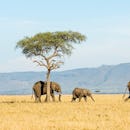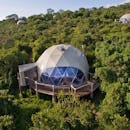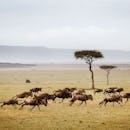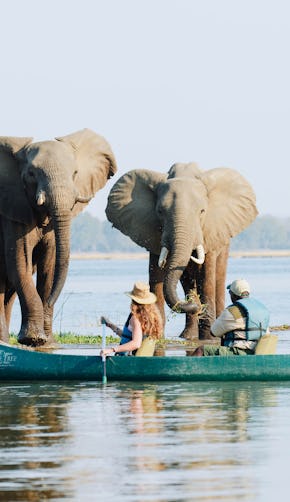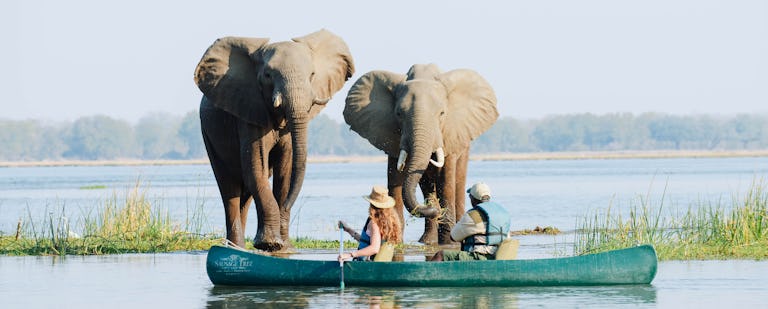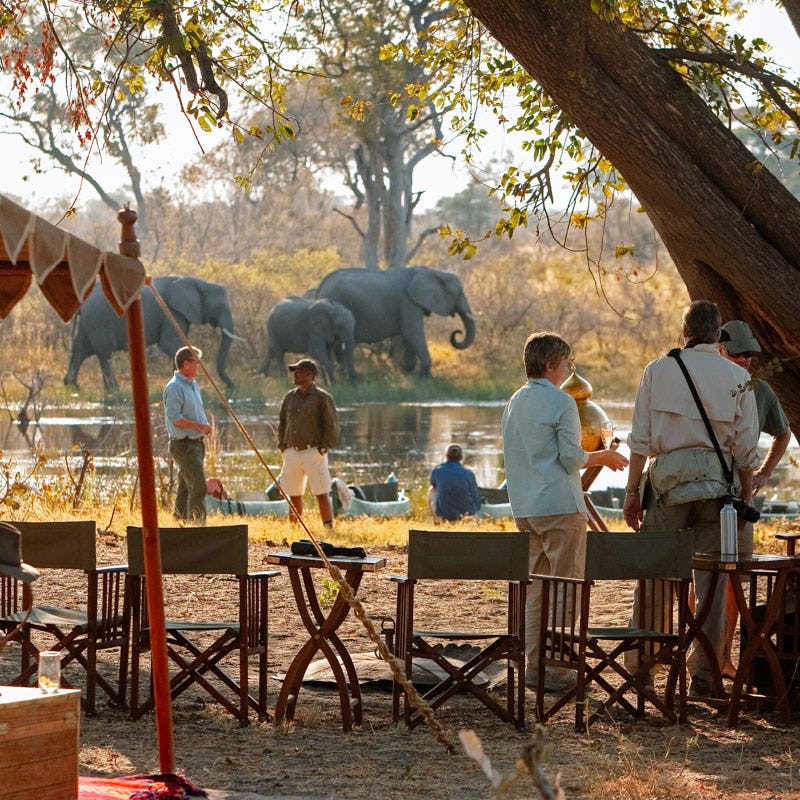An enormous, East African country that straddles the equator and borders eight other nations, Tanzania is a vast country with a varied, regional climate. As a general rule, it’s fair to say that the country has a mostly pleasant, tropical climate, but it is heavily influenced by altitude. For example, the low-lying coast is almost always hot and humid, whilst higher lying areas, like the Ngorongoro Crater, are far less sticky but temperatures can plummet to below 0 degrees-Celsius at night.
Within this regional variation, however, there are two distinct seasons: the ‘rainy’ season and the ‘dry’ season. These two seasons replace the typical four seasons that we in Europe and North America are typically used to. The rainy season is a vital aspect of Tanzania’s climate cycle and is essential for agriculture, replenishing water sources, and supporting the different ecosystems.
Happily for us and our visiting guests, Tanzania is known for being an all-year-round safari destination and if you would like to (or can only) travel during the rainy season months, there are still many things to enjoy – and sometimes even take advantage of! For a comprehensive dive into the highlights and weather during each month in Tanzania, please read our article on the best time to visit. What follows is our guide to everything you need to know about Tanzania’s rainy season, how to plan a trip, where to go, and our tips and tricks for making the most out of the season.
Please remember that this guide is not set in stone. Weather patterns are becoming increasingly erratic across the world as we face the challenges of global warming. In the last few years, researchers have noted droughts at the height of the rainy season in Tanzania, and rain in the middle of the driest months.

The Tanzania rainy season
As the name suggests, the rainy season in Tanzania is marked by heavy precipitation, however what many visitors do not know is that there are sunny periods with clear, blue skies during each day. Rain predominantly falls in the late afternoon and through the night, sometimes lasting until early the next morning. This allows for ample time in the day to explore when the sun is shining.
When is the rainy season in Tanzania?
Tanzania has two rainy seasons. The first is from the end of March to May (roughly) and is referred to as the ‘long rains’ or masika in the local language. The second rainy season takes place from November to December and is known as the short rains or vuli in the local language. The thunderstorms that come with the rains at both times of year are exceptionally dramatic and an incredible sight to behold, whilst the rain showers themselves can be very soothing and a welcome respite from the high temperatures.
The first rainy season begins at the end of March and signals the very end of the dry season, bringing relief to the dry and parched grounds. This rainy season begins with sporadic showers in March that intensify through April, with May being the wettest month.
The second rainy season occurs in November and December. The showers at this time of year are short and sharp but are still critical for replenishing the grasses and nutrients in the ground; almost like an injection or top-up of water in the middle of the dry season. The daily rain showers now are shorter than the earlier rainy season and by the end of December, the rain has disappeared almost entirely.
Advantages of travelling in Tanzania’s rainy season
Many people will choose to avoid the rainy season in Tanzania, however the combination of hot, wet weather makes for a warm and tropical safari experience. In fact, many travel specialists even refer to the rainy season in Tanzania as the “secret season” for its many advantages. Of course, each season has its quirks but these are some of our favourite reasons for travelling in Tanzania’s rainy season.
1. Great prices and special offers
Generally, the nightly rate in Tanzania’s safari camps and lodges, as well as in the city hotels and island resorts in Zanzibar and at the coast, is lower than that of the high and peak seasons. Costs can sometimes be reduced by as much as 40%, resulting in huge savings for guests travelling at this time of year. Add to this the ‘Stay 3 Pay 2’ or ‘Stay 4 Pay 3’ offers (you’ll get one night of free accommodation when you book a certain number of nights) that are popular during the rainy season, as well as discounted regional flights and transfers, and there are considerable savings to be had if you are interested in travelling in the rainy season.
Our trip, Explore Tanzania from north to south, offers exceptional savings on flights throughout the country, whilst this Discover Northern Tanzania trip saves on transfers between the lodges in the Serengeti and in the Ngorongoro Crater. Both offers are valid in the peak season, but the savings are even better if you choose to travel in the rainy season.
2. It’s much quieter in the rainy season
As we said before, many people will actively avoid visiting Tanzania during the rains. If you do choose to travel, you will have your pick of accommodation and animals. Large tour groups tend not to travel now and there is a noticeable difference in the number of vehicles driving around in the national parks meaning (virtually) crowd-free game viewing. Your photographs will be even better with the absence of other cars too…
This is particularly true in the Serengeti National Park. The iconic park has a reputation for being very busy, particular when the wildebeest of the Great Migration are crossing the Mara River in the north in July and August. If you were, however, to visit the northern Serengeti at the beginning of the year, from January to April, you might not find any wildebeest, but you will find wonderfully empty plains – empty of people that is, not wildlife! – exceptional, intimate wildlife sightings, and a serene and idyllic safari experience.

3. Photographers will love the light
Did you know that TV nature documentaries are often filmed during the rainy season in Tanzania? This is because the landscapes are lush and emerald green and the rain has washed away all traces of dust. The colours of the animals stand out beautifully against this vivid backdrop, making for crisp, bright photos that will take your breath away.
In the Ngorongoro Crater, wild flowers bloom on the floor of the crater just after the long rains in May and June. It’s a stunning spectacle, especially if you are lucky enough to catch a lion or even a rhino wandering through the blooms. Lodges like The Highlands Camp in Ngorongoro remain open all year, offering an excellent accommodation option for those willing to travel.
4. The migratory birds return
The period from November to April, encompassing both rainy seasons, is widely recognised as one of the best times for birding in Tanzania’s national parks. Firstly, it’s a great time to spot breeding birds as the rains provide abundant food as well as foliage coverage and it’s a real treat to see the birds in their breeding plumage. In the Ngorongoro Crater, the greater and lesser flamingos are big draws and they are best viewed in their breeding season from October to November.
The migratory species have also made their way over from the cold Northern hemisphere by November and there are lots of species to be spotted. In the Serengeti and Tarangire National Parks, you’re in with a chance of seeing migratory raptors like the pallid harrier and lesser kestrel, as well as smaller species like the European bee-eater or Caspian lapwing. The Tanzania rainy seasons really are a wonderful time to travel purely for birding.
5. Chimp trekking is excellent
There is good news for all chimpanzee trekkers in Tanzania’s rainy season, for the country’s top trekking destinations, Mahale Mountains and Rubondo Island are not only open in November and December, but offer truly superb experiences. In the Mahale Mountains, the chimps are often quite low down the mountain slopes in November, chasing after the ripe fruits, meaning reduced trekking times (albeit perhaps slightly harder treks on the wetter ground!). Even better, the sunsets are spectacular thanks to the dramatic, cloud-strewn skies – and did we mention that the nightly rates at Greystoke Mahale are reduced by 45%?
On Rubondo Island in Lake Victoria, the chimps are very active in November and December and can be more spread out in the forest as they look for food. But, the rainforest is showing off and groans under the weight of blooming wildflowers, lilies and orchids, and colourful butterflies flit in and out of the trees. The flights to the island (you will land at Mwanza Airport) can often be vastly reduced at this time of year too. Just remember your poncho!

The Great Migration in Tanzania’s rainy season
The Great Migration is a cyclical event that is dictated by the rains. The wildebeest traverse the Serengeti National Park (and into Kenya’s Masai Mara), chasing the rain that brings with it fresh, nutritious grasses and it’s one of the greatest natural events on the planet. We have many articles and resources available on the best time to see the Great Migration, where the wildebeest are and when, and where to stay to witness all the sights.
If you’re travelling in the rainy season and would like to see the Great Migration, we highly recommend heading to the southern Serengeti. From November onwards, the wildebeest congregate on these southern plains and when the first rains start to fall, the dry, parched landscape turns into a grassy paradise for the hungry animals. This fresh grass also provides expectant mothers with the nutrients required to give birth and in February and March, the height of the calving season, you’ll see many thousands of baby wildebeest tottering around the plains. This time of year offers a wonderful opportunity to interact with the herds in a very unique setting, and you’ll encounter far fewer other tourists than at the northern Mara River crossings in July and August. The accommodation in the south is also of an extremely high standard; take a look at Nyasi Migrational Camp for an authentic but highly luxurious experience, or Ndutu Kati Kati for a more rustic option.
In the April and May rainy season, the wildebeest are moving towards the western region of the Serengeti. As they pass through the central area of the Serengeti in April, the columns of herds stretch for several kilometres and are a staggering sight. Stay at Dunia Camp in the Moru Kopjes for the best viewing. Once the herds reach the western region, they are faced with the Grumeti River. Perhaps not as dramatic as the infamous northern crossings, watching the wildebeest navigate the murky waters of the Grumeti and the predators that lie in wait is still thrilling and exciting.
Mila Tented Camp, located in the remote Nyasirori region in the west, is in a prime location to see the wildebeest in May, as is Singita Faru Faru Tented Lodge, famed for its all-out safari chic and access to an exclusive, private reserve.

Zanzibar in Tanzania’s rainy season
On the coast, temperatures generally tend to be higher than mainland Tanzania and average around 30 degrees-Celsius year-round. The rainy season dates still apply here, with the long rains falling in April and May and the shorter rains in November and December but again, the showers tend not to last long and they often clear the air (and the humidity!) wonderfully. Rain showers may disrupt some outdoor activities temporarily, but as it’s likely that you will be visiting the island for a few days, there will always be periods of sunshine and blue skies to take advantage of. You might also be interested to know that scuba diving is possible in Zanzibar all year round, with March being a sweet spot before the long rains arrive and when the wind has died down.
The rainy season may not be the typical time for a beach holiday, but there are plenty of other activities to enjoy on the island. Many visitors take the time to enjoy the old Swahili culture of Zanzibar, exploring the historic sites of Stone Town, visiting the spice farms and walking in Jozani Forest, which is beautiful during the rains. Like the mainland, there is also a significant drop in accommodation prices in the rainy season, with many hotels offering rates reduced by up to 50% in April and May, and November, including Baraza Resort & Spa, and beautiful Zawadi.
Are there any disadvantages to travelling in Tanzania’s rainy season?
It goes without saying that you need to be prepared to get a little wet when travelling in the rainy season. But sometimes, that’s all part of the adventure – and if you have good, all-weather gear like a poncho or a waterproof jacket (and plenty of socks!) in your suitcase, there is no reason for the weather to affect your trip.
One disadvantage that we can think of is that some parts of the country are inaccessible during very rainy periods. This is often the case in Southern Tanzania where many camps will close in April and May in Ruaha and Nyerere National Park. We do however work with some excellent properties that stay open for the majority of the year in Southern Tanzania and provide a fantastic experience for guests, regardless of what the weather is doing.
In a similar vein, the rainy season perhaps isn’t the best time to travel for a more off-the-beaten track safari experience. In Katavi, most camps will close from the end of November until the following June, and in Ruaha, many of the smaller walking and expeditionary camps close for the same length of time due to the wet grounds.
Travelling in Tanzania’s rainy season might not be for everyone, but should you decide to visit in what are typically considered the wet season months, there are some huge advantages. Our Timbuktu travel specialists are always on hand to help find a trip that is right for you – please get in touch if you would like more information about safaris, trips and tours in Tanzania.














